

Introduction
Welcome to the vibrant and thought-provoking world of John Gardner’s “Grendel” 📚! First published in 1971, this novel offers a fresh perspective on the Anglo-Saxon epic poem “Beowulf”, by retelling the story from the viewpoint of its antagonist, Grendel. This intriguing shift not only illuminates the tale from the monster’s perspective but also explores deep themes of existentialism, morality, and the nature of evil.
John Gardner (1933-1982) was an American novelist, essayist, literary critic, and university professor. His works are celebrated for their deep philosophical underpinnings and exploration of human nature. “Grendel,” in particular, stands out for its innovative narrative technique and its complex examination of its titular character.
As for the genre, “Grendel” straddles the lines between fantasy, philosophy, and classic literature, making it a unique and compelling read. Gardner’s novel has captivated readers and scholars alike, encouraging them to ponder the essence of storytelling and the myriad ways in which a narrative can be perceived and understood.
Ready to dive deeper into the world of Grendel, Beowulf, and the existential queries that Gardner so masterfully presents? Let’s embark on this literary journey together! 🌟
Plot Summary
“Grendel” by John Gardner is a novel that takes us deep into the life and psyche of the titular character, offering a narrative rich in exploration and existential angst. Here’s a detailed breakdown of the main events:
Exposition — The story begins with Grendel’s own words, introducing us to his world, his philosophical ponderings, and his initial encounters with humans. Living with his mute mother in a cave, Grendel is depicted as a creature caught between two worlds – the animal kingdom and the realm of men, belonging fully to neither.
Rising Action — Grendel’s interactions with humans intensify, leading to a cycle of violence and revenge. He is drawn to Hrothgar’s hall, fascinated and repelled by the humans’ behaviors and their social structures. Grendel’s existential musings are deepened through his encounters with a dragon, who provides him with a nihilistic view of the universe, suggesting that nothing he does truly matters. This encounter leaves Grendel with the ability to not be harmed by human weapons, further isolating him.
Climax — The climax of the novel occurs with the arrival of Beowulf, who represents a new challenge and a turning point for Grendel. Unlike the other men Grendel has encountered, Beowulf is a formidable opponent whose strength and demeanor perplex Grendel. Their confrontation in Grendel’s cave marks the peak of Grendel’s existential crisis and his struggle against the inevitability of his fate.
Falling Action — The battle between Grendel and Beowulf is intense and introspective, with Grendel forced to confront his own nature and the consequences of his actions. Beowulf’s strength and determination overwhelm Grendel, leading to his retreat, mortally wounded.
Resolution — Grendel’s story ends as he stumbles away from the battle, reflecting on his life, his choices, and the nature of existence. His final moments are introspective, filled with a complex mixture of regret, acceptance, and a poignant questioning of the meaning of life and death. Grendel dies alone, contemplating the vast, indifferent universe.
Through these events, Gardner crafts a narrative that challenges our perceptions of villainy and heroism, forcing us to question the nature of evil and the complexities of the human condition.
Character Analysis
In “Grendel,” John Gardner presents a cast of characters that are rich in complexity and depth. Here’s a closer look at the main characters and their developments throughout the story.
- Grendel — The protagonist, Grendel, is a creature torn between two worlds, struggling with his identity and purpose. Initially curious about humans, he becomes increasingly cynical and violent after being rejected by them. Grendel’s philosophical inquiries and existential angst drive much of the novel’s narrative, making him a deeply introspective character. His encounters with the dragon and Beowulf significantly shape his worldview, leading him to a nihilistic acceptance of his fate.
- The Dragon — The dragon is a creature of immense wisdom and power, possessing a cynical and fatalistic view of the universe. It sees all of time simultaneously and shares with Grendel a vision of the world that is indifferent and cyclic. The dragon’s perspective profoundly influences Grendel, pushing him towards a path of existential despair.
- Beowulf — Beowulf is the legendary hero who confronts Grendel. He is characterized by his physical strength, courage, and mysterious qualities. Unlike other characters, Beowulf seems to operate on a different moral and existential plane, serving as Grendel’s ultimate challenge and nemesis. His encounter with Grendel is pivotal, showcasing a clash of philosophies and strengths.
- Hrothgar — The king of the Danes, Hrothgar, is a complex leader who builds the great hall, Heorot, as a symbol of his people’s achievements and unity. Grendel’s attacks on Heorot and his interactions with Hrothgar highlight the fragility of human accomplishments and the perpetual struggle against chaos and darkness.
This analysis reveals how Gardner’s characters are not merely figures in a story but embodiments of different philosophical perspectives and existential queries. Through them, “Grendel” explores the depths of what it means to be, to struggle, and to seek meaning in an often incomprehensible world.
Themes and Symbols
“Grendel” by John Gardner is rich with themes and symbols that weave through its narrative, adding layers of meaning and inviting readers to delve into deep philosophical questions. Here’s a look at some of the major themes and symbols in the novel:
- Existentialism and the Search for Meaning — Grendel’s journey is fundamentally one of existential inquiry. He grapples with the meaningless of existence, the isolation of the individual, and the search for purpose in an indifferent universe. His interactions with other characters, especially the dragon, highlight the existentialist theme that life’s inherent meaninglessness forces individuals to create their own purpose.
- Nature of Evil and Duality — The novel explores the nature of evil by presenting Grendel not as a mere monster, but as a thinking, feeling being who struggles with his actions and their justification. This blurs the lines between hero and villain, good and evil, suggesting that these concepts are not absolute but depend on perspective and context.
- Isolation and Alienation — Grendel’s alienation from both the animal world and human society underscores the theme of isolation. His inability to communicate with his mother and the humans’ rejection of him deepen his solitude, reflecting on the existential theme of man’s inherent isolation in the universe.
- Cycles of History and Violence — The repetitive attacks on Hrothgar’s hall and the cyclical nature of Grendel’s encounters with humans reflect the theme of history’s repetitiveness and the inevitability of violence. The dragon’s perspective that nothing changes underscores this theme, suggesting a deterministic view of history.
- The Dragon’s Hoard — Symbolizes the futility of material wealth and the human obsession with transient possessions. It also represents the dragon’s nihilistic worldview, as it hoards gold for no reason other than to have it.
- Heorot Hall — Represents human civilization, community, and the attempt to ward off the existential darkness with light, warmth, and companionship. It stands as a testament to human achievement but also as a beacon that attracts Grendel’s attention and violence.
- The Shaper — Symbolizes the power of art, storytelling, and culture to create meaning, shape societal values, and influence perceptions of reality. The Shaper’s songs offer a contrast to Grendel’s nihilistic view, suggesting that meaning can be constructed even if it is not inherent.
Through these themes and symbols, “Grendel” prompts readers to reflect on profound questions about existence, morality, and the human condition, making John Gardner’s novel a timeless exploration of the depths of philosophical inquiry.
Style and Tone
John Gardner’s “Grendel” is notable not just for its intriguing content but also for its distinctive style and tone, which play crucial roles in shaping the mood and atmosphere of the book. Let’s dive into these aspects:
- First-Person Narrative — The story is told from Grendel’s perspective, allowing readers intimate access to the thoughts and feelings of the monster. This narrative choice deepens the reader’s understanding of Grendel’s existential crises and his complex relationship with humans and the world around him.
- Philosophical Monologues — Grendel often engages in long, introspective monologues. These passages are dense with existential ponderings and philosophical inquiries, reflecting Grendel’s internal struggles and his quest for meaning in an indifferent universe.
- Dark Humor — Despite its heavy themes, Gardner’s writing is laced with dark humor. Grendel’s observations of human absurdities, his interactions with the dragon, and even his reflections on his own nature often contain a biting wit that lightens the narrative’s tone while underscoring its themes.
- Poetic Language and Imagery — The novel is rich in vivid descriptions and poetic language, particularly in the portrayal of the natural world and Grendel’s sensory experiences. Gardner’s use of imagery not only enhances the mood but also serves to highlight the contrast between beauty and brutality, isolation and connection.
- Shifts in Tone — The tone of the novel shifts dramatically, mirroring Grendel’s emotional and philosophical development. From curiosity and wonder to cynicism and despair, these shifts convey the complexity of Grendel’s character and his existential journey.
- Symbolism and Allegory — Gardner employs symbols and allegory to deepen the narrative’s meaning and to engage with its themes on multiple levels. The characters, settings, and events become symbols for broader existential and philosophical inquiries, enriching the reader’s experience.
- Mixture of Genres — “Grendel” blends elements of myth, tragedy, and philosophical fiction, creating a unique narrative that defies easy categorization. This genre-mixing contributes to the novel’s rich tapestry of themes and ideas, and its ability to appeal to a wide range of readers.
Gardner’s distinctive style and tone in “Grendel” not only make it a compelling read but also enhance its exploration of deep philosophical questions, making the novel a profound and enduring work of literature.
Literary Devices used in Grendel
In “Grendel,” John Gardner masterfully employs a variety of literary devices to enrich the narrative, deepen thematic explorations, and enhance the reader’s engagement with the text. Here are the top 10 literary devices used in the novel:
- Allusion — Gardner frequently references mythology , philosophy, and classical literature, creating a rich intertextual dialogue that deepens the novel’s themes. For instance, the allusions to Cain and Abel from the Bible highlight Grendel’s cursed nature and existential isolation.
- Metaphor — The novel is replete with metaphors that convey complex themes and emotions. Grendel’s cave, for example, serves as a metaphor for his isolation and separation from the world of men.
- Symbolism — Objects, characters, and settings are imbued with symbolic meaning. The dragon’s hoard symbolizes the futility of material wealth, while Heorot Hall represents human civilization and the collective effort to fend off the existential void.
- Irony — Gardner uses irony to underscore the absurdity of certain situations and the contrast between appearance and reality. Grendel’s quest for understanding and connection leads, ironically, to further alienation and destruction.
- Foreshadowing — The novel contains hints and clues about future events, such as the dragon’s cryptic predictions about Grendel’s fate, which foreshadow his encounter with Beowulf and eventual demise.
- Imagery — Vivid imagery is used to evoke a sense of place, mood, and atmosphere. Descriptions of the natural world, the seasons, and the characters’ actions create a vivid, immersive experience for the reader.
- Personification — Gardner gives human qualities to non-human entities, such as when nature itself seems to react to Grendel’s turmoil. This personification deepens the connection between Grendel and the world he inhabits.
- Stream of Consciousness — The novel employs a stream-of-consciousness technique to represent Grendel’s thoughts and feelings, allowing readers to experience his inner turmoil and philosophical musings directly.
- Paradox — The text is filled with paradoxical statements and situations that reflect the complexity of Grendel’s existence and the novel’s themes. For example, Grendel’s simultaneous desire for connection and destruction embodies a fundamental paradox of his character.
- Anaphora — Repetition of words or phrases at the beginning of consecutive sentences or clauses is used for emphasis and to build a rhythm. This device is evident in Grendel’s monologues, reinforcing his obsessive contemplation and existential angst.
These literary devices are integral to “Grendel’s” narrative structure and thematic depth, showcasing Gardner’s skill as a storyteller and his novel’s enduring literary value.
Literary Devices Examples
Here, we’ll provide examples and explanations for each of the top 10 literary devices used in John Gardner’s “Grendel” in a structured table format.
Foreshadowing
Personification, stream of consciousness.
These examples showcase how John Gardner employs literary devices to enhance the thematic depth, emotional impact, and narrative complexity of “Grendel,” making it a rich and engaging read.
Grendel – FAQs
What is “Grendel” about? “Grendel” is a novel by John Gardner that retells the story of the Anglo-Saxon epic “Beowulf” from the perspective of the antagonist, Grendel. It explores themes of existentialism, the nature of evil, and the human condition through the eyes of the monster.
Who wrote “Grendel” and when was it published? John Gardner, an American novelist and academic, wrote “Grendel.” It was first published in 1971.
Why does Grendel attack Hrothgar’s hall? Grendel attacks Hrothgar’s hall, initially, out of curiosity and a desire to understand the humans. However, his actions become more aggressive and cynical as he feels rejected and despised by the human world, leading to a cycle of violence.
What philosophical themes are explored in “Grendel”? “Grendel” delves into several philosophical themes, including existentialism, the search for meaning, the nature of evil, and the individual’s relationship to society and the universe.
How does Grendel’s character develop throughout the novel? Grendel evolves from being a curious and somewhat naive creature to a more cynical and nihilistic being. His encounters with the dragon, Hrothgar, and Beowulf profoundly shape his worldview and understanding of his place in the universe.
What is the significance of the dragon in “Grendel”? The dragon in “Grendel” represents a nihilistic perspective on existence, suggesting that life is meaningless and that individuals must create their own purpose. His conversation with Grendel introduces the monster to a broader, more cynical view of the world.
How does “Grendel” relate to “Beowulf”? While “Beowulf” is a heroic epic that celebrates the deeds of the great hero Beowulf, “Grendel” offers a contrasting perspective by focusing on the story’s antagonist. It provides insight into Grendel’s thoughts and motivations, presenting a nuanced view of the tale.
What literary devices are used in “Grendel”? John Gardner employs a variety of literary devices in “Grendel,” including allusion, metaphor, symbolism, irony, foreshadowing, imagery, personification, stream of consciousness, paradox, and anaphora, to enhance the narrative’s depth and complexity.
Can “Grendel” be considered a tragedy? Yes, “Grendel” can be considered a tragedy as it follows the downfall of its protagonist, who, despite his efforts to find meaning and connection, is ultimately defeated and killed, reflecting the tragic nature of his existential quest.
What makes “Grendel” a unique work of literature? “Grendel” stands out for its innovative narrative perspective, philosophical depth, and the complex character exploration of its titular monster, making it a unique and enduring contribution to American literature and the broader literary canon.
This quiz is designed to test your comprehension and understanding of “Grendel” by John Gardner, covering key aspects of the plot, characters, themes, and literary devices.
Spot the Literary Devices
Read the following paragraph from “Grendel” and identify the literary devices used:
“In the twelfth year of my idiotic war against the hairy men, I watched the sky through the leafless limbs of my forest perch. The stars, cold and indifferent, stared back, unblinking, at my upturned face. I understood then, with a feeling of sinking despair, that the universe was vast, uncaring, and ultimately meaningless. Each star was a reminder of my isolation, my insignificance in the grand scheme of things.”
- Imagery — “watched the sky through the leafless limbs of my forest perch” vividly describes the setting and Grendel’s perspective.
- Personification — “The stars, cold and indifferent, stared back, unblinking, at my upturned face” gives the stars human qualities, emphasizing Grendel’s loneliness.
- Symbolism — The stars symbolize Grendel’s isolation and the vast, indifferent universe.
- Metaphor — “my idiotic war against the hairy men” metaphorically describes Grendel’s conflict with humans, hinting at its futility and Grendel’s self-awareness of its pointlessness.
- Paradox — “a feeling of sinking despair” in an “uncaring and ultimately meaningless” universe suggests the paradox of feeling despair in the face of meaninglessness.
This exercise helps illustrate how John Gardner uses a range of literary devices in “Grendel” to convey complex emotions and themes, enriching the narrative with depth and nuance.

John Gardner
Ask litcharts ai: the answer to your questions.
In the background of the novel is perhaps English literature’s most significant text about heroism: Beowulf . Whereas the epic poem Beowulf builds up the idea of a hero, much of Grendel criticizes and pokes fun at the very idea of heroism. From Grendel’s perspective, the heroic feats celebrated by the Shaper are all lies. The Danes’ exploits are simply examples of “violence no more legitimate than a wolf’s.” Hrothgar’s amassing of riches and tribute is perhaps no different from the dragon’s selfish hoarding of treasure.
Grendel is especially able to mock ideals of heroism through his interactions with Unferth . By refusing to fight Unferth and instead throwing apples at him, he humiliates the hero and turns what should be a noble fight into a kind of pathetic slapstick comedy. By refusing to kill Unferth, Grendel denies him a heroic death and demoralizes him, showing him the emptiness of his ideas of heroism.
When Beowulf finally arrives and defeats Grendel, the novel presents the closest thing to a true hero. Stronger and cleverer than all the Danes, Beowulf overcomes Grendel in dramatic combat. But even as he dies, Grendel painstakingly maintains that his death is not the result of a heroic deed. With his dying breaths, Grendel insists that Beowulf defeated him through trickery and by sheer chance. Even as the novel seems to give an example of a true hero defeating an enemy, Grendel goes to the grave insisting that there is no such thing as real heroism, that Beowulf simply got lucky in one act of violence as meaningless as any other.
Heroism ThemeTracker
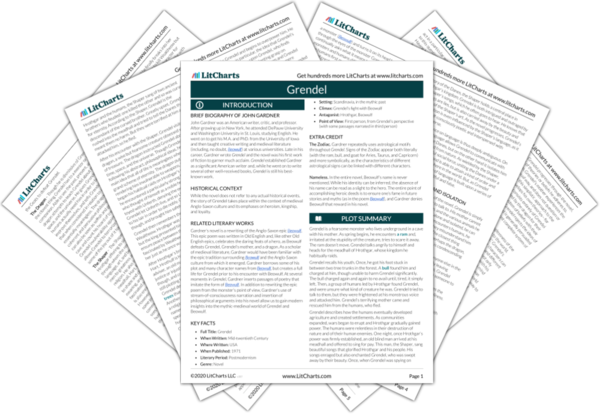
Heroism Quotes in Grendel
Then once, around midnight, I came to a hall in ruins. The cows in their pens lay burbling blood through their nostrils, with javelin holes in their necks. None had been eaten. The watchdogs lay like dark wet stones, with their heads cut off, teeth bared. The fallen hall was a square of flames and acrid smoke, and the people inside (none of them had been eaten either) were burned black, small, like dwarfs turned dark and crisp.
“It will be sung,” he whispered, then paused again to get wind. “It will be sung year on year and age on age that Unferth went down through the burning lake—” he paused to pant “—and gave his life in battle with the world-rim monster.” He let his cheek fall to the floor and lay panting for a long time, saying nothing. It dawned on me that he was waiting for me to kill him. I did nothing. I sat down and put my elbows on my knees and my chin on my fists and merely watched.

This nobility of his, this dignity: are they not my work? What was he before? nothing! A swollen-headed raider, full of boasts and stupid jokes and mead. ...I made him what he is. Have I not a right to test my own creation?
“It was an accident,” I bellow back. I will cling to what is true. “Blind, mindless, mechanical. Mere logic of chance.”
by John Gardner
- Grendel Summary
Grendel tells the story of Grendel and Hrothgar 's intertwined fates leading up to the arrival of Beowulf. The novel reflects upon Grendel's twelve years at war with Hrothgar and his people, with each chapter focusing on a different philosophical school of thought under consideration by Grendel. The overarching plot is Grendel's search for meaning and identity in what appears to be a meaningless cosmos. Through his quest, Grendel meets a variety of characters, from Hrothgar, his human foil, to the dragon, a would-be mentor whose highest thought is the meaningless of all existence. Grendel passes the seasons paradoxically avoiding and seeking out the company of the local humans, the Scyldings, and observes their development as a civilization and as individuals with great interest.
Grendel begins his journey of discovery when he accidentally finds a passageway leading out of his subterranean home. His first encounters with the world outside are both marvelous and disheartening, particularly as his first moment of weakness leads to an attack by a bull, followed by torment at the hands of the first humans with which Grendel interacts. From that point on, Grendel's search for personal meaning intertwines with his desire to torment the humans and Hrothgar in particular. Grendel's encounters with the dragon and with various human agents only result in further frustration for the monster. The people he wishes to join ostracize him, so he practices further self-isolation by making his presence among them terrifying.
Nonetheless, Grendel feels haunted by the beauty and creativity of the human mind, particularly as embodied in the words and song of the Shaper. Grendel's frustration is not simply a matter of loneliness; he also cannot choose between his hatred of humanity on the one hand, and his admiration of man's accomplishments on the other.
The novel ends where its inspiration, the epic Beowulf , begins--with the arrival of the mighty Geat soon after one of Grendel's bloodier rampages. Grendel, we know, is doomed to die by Beowulf's hand. In Grendel , Gardner makes that death a matter of great philosophical import.

Grendel Questions and Answers
The Question and Answer section for Grendel is a great resource to ask questions, find answers, and discuss the novel.
How was Grendel's mother and his relationship?
In Chapter Two, Grendel reflects on his childhood. He used to play games in the subterranean home he shared with his mother. He would attack and hide from shadows as he explored the myriad caves. He discovers the pool of the fire snakes, which he...
How does this selection portray Grendel's personality and motives ?
I'm sorry, you haven't provided the selection in question.
Why is Grendel so angry and homicidal?
Grendel's first encounters with the world outside are both marvelous and disheartening, particularly as his first moment of weakness leads to an attack by a bull, followed by torment at the hands of the first humans with which Grendel interacts....
Study Guide for Grendel
Grendel study guide contains a biography of John Gardner, literature essays, quiz questions, major themes, characters, and a full summary and analysis.
- About Grendel
- Character List
Essays for Grendel
Grendel essays are academic essays for citation. These papers were written primarily by students and provide critical analysis of Grendel.
- Existential Philosophy in John Gardner's Grendel
- Pain of Isolation
- Grendel's Darkness
- Astrological Signs as Symbols in Grendel
- The Consequences of Grendel's Solipsism
Lesson Plan for Grendel
- About the Author
- Study Objectives
- Common Core Standards
- Introduction to Grendel
- Relationship to Other Books
- Bringing in Technology
- Notes to the Teacher
- Related Links
- Grendel Bibliography

Wikipedia Entries for Grendel
- Introduction
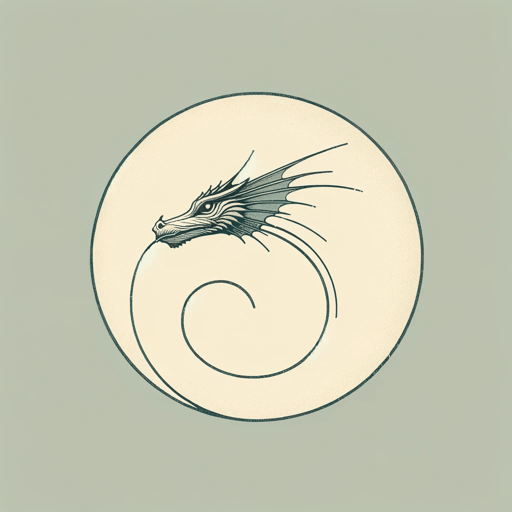
82 pages • 2 hours read
A modern alternative to SparkNotes and CliffsNotes, SuperSummary offers high-quality Study Guides with detailed chapter summaries and analysis of major themes, characters, and more. For select classroom titles, we also provide Teaching Guides with discussion and quiz questions to prompt student engagement.
Introduction
Before Reading
Reading Context
During Reading
Reading Questions & Paired Texts
After Reading
Discussion/Analysis Prompt
Essay Questions
Exam Questions
Exam Answer Key
Use these essay questions as writing and critical thinking exercises for all levels of writers, and to build their literary analysis skills by requiring textual references throughout the essay.
Differentiation Suggestion: For English learners or struggling writers, strategies that work well include graphic organizers, sentence frames or starters, group work, or oral responses.
Get access to this full Teaching Guide and much more!
- 7,500+ In-Depth Study Guides
- 4,900+ Quick-Read Plot Summaries
- Downloadable PDFs
Scaffolded Essay Questions
Student Prompt: Write a short (1-3 paragraph) response using one of the bulleted outlines below. Cite details from the text over the course of your response that serve as examples and support.
The SuperSummary difference
- 8x more resources than SparkNotes and CliffsNotes combined
- Study Guides you won ' t find anywhere else
- 100+ new titles every month
1. Grendel is isolated from humanity because he is viewed as “the Other.” In fact, Grendel’s human counterpart is likely Hrothgar, though Hrothgar is unaware of this relationship.
- As the Other, what role does Grendel serve in the life of Hrothgar? ( topic sentence )
- Discuss the role Grendel plays in the rise of Hrothgar’s kingdom.
- In your closing sentences, discuss Grendel’s pity for the aging Hrothgar.
2. Grendel feels a particular affection for the Shaper.
- How do Grendel’s feelings toward the Shaper alter over the course of the novel, and why? ( topic sentence )
- In what ways does the role the Shaper plays in Grendel’s life mirror or contrast with the role the Shaper plays in the lives of the Danes?

Don't Miss Out!
Access Teaching Guide Now
Related Titles
By John Gardner

The Art of Fiction
John Gardner
Featured Collections
View Collection
Good & Evil
Hate & Anger
Order & Chaos
Required Reading Lists
School Book List Titles
Home — Essay Samples — Literature — Beowulf — Beowulf And Grendel Comparison
Beowulf and Grendel Comparison
- Categories: Beowulf Grendel
About this sample

Words: 639 |
Published: Mar 5, 2024
Words: 639 | Page: 1 | 4 min read

Cite this Essay
Let us write you an essay from scratch
- 450+ experts on 30 subjects ready to help
- Custom essay delivered in as few as 3 hours
Get high-quality help

Dr. Karlyna PhD
Verified writer
- Expert in: Literature

+ 120 experts online
By clicking “Check Writers’ Offers”, you agree to our terms of service and privacy policy . We’ll occasionally send you promo and account related email
No need to pay just yet!
Related Essays
2 pages / 817 words
3 pages / 1287 words
2 pages / 725 words
2.5 pages / 1065 words
Remember! This is just a sample.
You can get your custom paper by one of our expert writers.
121 writers online
Still can’t find what you need?
Browse our vast selection of original essay samples, each expertly formatted and styled
Related Essays on Beowulf
Beowulf, the legendary hero of the Old English epic poem of the same name, is known for his numerous accomplishments throughout the narrative. From defeating monstrous creatures to serving his people with honor and bravery, [...]
Loyalty is a central theme in the epic poem Beowulf, which tells the story of a heroic warrior who must navigate the complexities of loyalty in order to protect his people and achieve greatness. This essay will explore how [...]
The epic poem Beowulf is known for its use of caesura, a pause or break in the middle of a line of poetry. These pauses serve to add rhythm, emphasis, and structure to the text, allowing the reader to better understand and [...]
Alliteration, the repetition of initial consonant sounds in neighboring words, is a literary device that has been used for centuries to enhance the auditory experience of a text. In the epic poem Beowulf, alliteration plays a [...]
The epic poem Beowulf is a rich tapestry of vivid and descriptive language that immerses readers in the world of the Geats and the Danes. One of the most captivating aspects of the poem is the use of kennings, which are compound [...]
This is my comparison of Robert Zemeckis’ 2007 movie Beowulf and of the epic poem Beowulf. Robert Zemeckis’ 2007 movie tells the story of Beowulf, the character. However, they share not only similarities but also share [...]
Related Topics
By clicking “Send”, you agree to our Terms of service and Privacy statement . We will occasionally send you account related emails.
Where do you want us to send this sample?
By clicking “Continue”, you agree to our terms of service and privacy policy.
Be careful. This essay is not unique
This essay was donated by a student and is likely to have been used and submitted before
Download this Sample
Free samples may contain mistakes and not unique parts
Sorry, we could not paraphrase this essay. Our professional writers can rewrite it and get you a unique paper.
Please check your inbox.
We can write you a custom essay that will follow your exact instructions and meet the deadlines. Let's fix your grades together!
Get Your Personalized Essay in 3 Hours or Less!
We use cookies to personalyze your web-site experience. By continuing we’ll assume you board with our cookie policy .
- Instructions Followed To The Letter
- Deadlines Met At Every Stage
- Unique And Plagiarism Free
Beowulf Theme Essay
Beowulf is an epic poem that tells the story of Beowulf, a brave warrior who defeats the monster Grendel and saves his people. Beowulf is a great example of epic poetry, and it contains many themes that are still relevant today. Some of the important themes in Beowulf include courage, strength, loyalty, and honor. These themes are evident throughout the poem and help to make Beowulf a timeless classic.
The thesis, or central idea, is the core message that is expressed in the narrative. The purpose of the theme is to convey the moral of the tale. Some stories have only one major topic, but others may have many. Beowulf is one of those tales with more than one major topic. The themes of Beowulf are good vs. evil, loyalty, and bravery.
One of the most important themes in Beowulf is the theme of good versus evil. Beowulf is a story about a young hero who defeats an evil monster, Grendel. Grendel terrorizes the people of Heorot until Beowulf comes to fight him. Beowulf ultimately defeats Grendel, but Grendel’s mother seeks revenge. Beowulf then kills her too. The story ends with Beowulf defeating a dragon but being mortally wounded in the process. Although he dies, Beowulf is remembered as a great hero who fought against evil and protected his people.
Another important theme in Beowulf is loyalty. Beowulf shows his loyalty to Hrothgar by defeating Grendel. Beowulf is also loyal to his men, risking his own life to save them from the dragon. Beowulf’s men are also loyal to him, willing to fight alongside him even though they know they may not survive.
The last important theme in Beowulf is bravery. Beowulf is a brave hero who is not afraid to fight evil. He puts his own life at risk to save others. Beowulf’s bravery is what makes him a great hero and an important figure in the story.
Beowulf is a story with many important themes. The themes of good versus evil, loyalty, and bravery are all central to the story. These themes help to convey the moral of the tale and make Beowulf a great epic poem.
The theme of loyalty appears frequently in Beowulf. Beowulf proved his devotion to Hygelac the king at the conclusion of the poem, stating that he was loyal to him.He gave me land and the security it provides, so he had no right to look for a lesser hero” (lines 3069-3074). What is presented here is that Beowulf was dedicated to King Hygelac because in return for his loyalty, he was rewarded with riches.
Beowulf is also shown to be extremely loyal to his people as he puts their safety before his own. After Beowulf kills Grendel’s mother, he could have easily taken the treasure and left but instead he makes sure that the people are safe. “I’m going down into her dark dwelling, so hand me my battle gear! I don’t doubt that I’ll manage better on my own than with a troop of men – unless it’s God’s will that I die down there.” Beowulf puts his people’s safety above his own life which shows great loyalty.
Another theme in Beowulf is revenge. This is seen when Beowulf goes after Grendel’s mother to avenge Aeschere’s death. Beowulf says “To avenge my friend’s death, I’ll descend into that awful place. I know it’s risky, but I’ve been waiting for an opportunity like this – all the more because Grendel caused such havoc in Heorot.” Beowulf puts his life at risk to avenge Aeschere’s death which shows how important revenge is to him.
The last theme that will be discussed is fame. Beowulf fights Grendel and Grendel’s mother to achieve fame. Beowulf says “Fame is the highest good; it lives on after us in story and song…I hope to win renown that will never die.” Beowulf is only interested in fighting Grendel and Grendel’s mother to achieve fame and nothing else. He is not interested in the treasure or any rewards, only fame.
Beowulf is an epic poem that tells the story of Beowulf, a hero who fights two monsters, Grendel and Grendel’s mother. The poem explores the themes of loyalty, revenge, and fame. Beowulf is shown to be extremely loyal to his king and people. He puts their safety above his own life which shows great loyalty. Beowulf is also motivated by revenge when he goes after Grendel’s mother. He wants to avenge Aeschere’s death.
When Wiglaf is threatened by the dragon, he fights bravely with Beowulf. “Your accomplishments are well-known; therefore stay strong, my lord, and defend your life to the best of your ability now. I will stand by you.”
Beowulf went to kill the dragon because it was terrorizing a village. Beowulf fights evil for the greater good even though he knows he may die in the process. “And Beowulf, Ecgtheow’s son/ Boarded a ship with his band of thanes…He had heard that Grendel/ Was attacking Hrothgar’s great mead-hall.” Beowulf is also willing to put himself in danger to save others from evil.
The main theme of Beowulf, as in most tales, refers to everyone in real life. Beowulf shows that in order to live a complete life, we must regularly seek out and overcome barriers. It is frequently necessary to head in new directions in order to discover who we are since con-fronting the things we fear often entails coming into conflict with our preconceptions. This is true no matter what the consequences may be because every person will need bravery at some point when faced with these hurdles.
Beowulf is an epic poem written in Old English, probably in the 8th century. The poem tells the story of Beowulf, a hero from Geatland who comes to the aid of Hrothgar, king of the Danes, when he is being terrorized by a monster named Grendel. Beowulf eventually defeats both Grendel and his mother, but is mortally wounded in the process. He dies after defeating a dragon that was terrorizing his homeland.
The themes present in Beowulf are still relevant today. We all face challenges and obstacles in our lives, and we all have fears that we must overcome. Beowulf shows us that it is possible to overcome these challenges and fears, and that doing so can lead to a life that is full and fulfilling.
While Beowulf is often considered to be a story about bravery, it is also a story about strength. Beowulf has great strength, both physical and mental. He is able to overcome challenges that would be impossible for most people. This strength allows him to protect others from harm, and to defeat powerful enemies.
Beowulf also teaches us about the importance of family and friends. Beowulf has a close relationship with his kin, and he is willing to risk his life to help them. He also forms strong bonds with the people he meets during his travels. These bonds are what allow him to defeat Grendel and his mother, and to ultimately overcome the dragon.
Beowulf is an epic poem that tells a story that is still relevant today. The themes of bravery, strength, and family are all present in the poem, and they are all things that we can relate to in our own lives. Beowulf is a great example of how these themes can be used to create a full and fulfilling life.
More Essays
- Beowulf As A Hero In Beowulf and Grendel
- Essay on The Anglo-Saxon Theme Of Family And Brotherhood In Beowulf
- Beowulf Is Not A Hero
- Beowulf Symbolism Essay
- Beowulf: Unferth, the Same Martyr
- Beowulf Good vs Evil Essay
- Beowulf – epic tale
- The Character of Unferth in Beowulf and Grendel
- Is Beowulf An Epic Hero
- Beowulf-Christianity or Paganism
Leave a Comment Cancel reply
Save my name, email, and website in this browser for the next time I comment.
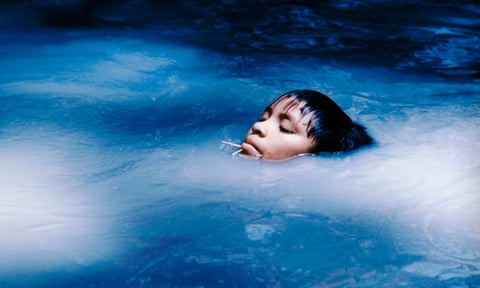
The origin of all things: Kyotographie 2024 – a photo essay
The 12 th annual Kyotographie photography festival features 13 exhibitions staged in striking locations across the Japanese city of Kyoto. Photographers from around the world submitted pictures on the theme of ‘source’
- The Kyotographie international photography festival runs until 12 May
S pring in Kyoto ushers in cherry blossom season, but it also marks the return of one of the biggest photo festivals in Asia. Kyotographie, now in its 12th year, fuses the past and present with its striking images and unique locations. The 13 exhibitions are staged in temples, galleries and traditional private homes across the Japanese city, showcasing the work of national and international photographers.
The festival is loosely centred on a theme – and this year the directors, Lucille Reyboz and Yusuke Nakanishi, asked participants to focus on the word “source” by delving into the essence of beginnings and the nexus of creation and discovery.

The Yamomami struggle. Photograph by Claudia Andujar
The source is the initiator, the origin of all things. It is the creation of life, a place where conflict arises or freedom is obtained; it is the space in which something is found, born or created. It is a struggle Claudia Andujar and the Yanomami shaman and leader Davi Kopenawa know too well. The Yanomami Struggle is the first retrospective exhibition in Japan by the Brazilian artist and activist Andujar with the Yanomami people of Brazil.
It is more than 50 years since she began photographing the Yanomami, the people of the Amazon rainforest near Brazil’s border with Venezuela, an initial encounter that changed their lives. Andujar’s work is not just a showcase of her photographic talent but, with Kopenawa accompanying the exhibition to Japan for the first time, it is a platform to bring the Yanomami’s message to a wider Asian audience.
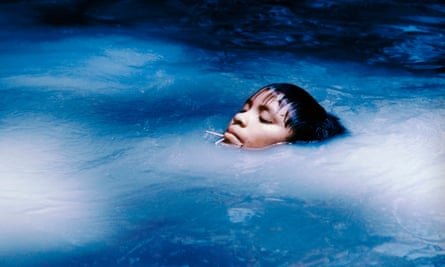
The Yanomami Struggle. Photograph by Claudia Andujar
The first part of the exhibition features photographs taken by Andjuar in the 1970s, alongside artwork by the Yanomami people and words by Kopenawa. The second part narrates the continuing violence inflicted by non-Indigenous society on the Yanomami. The project is a platform for the Yamomani people to be seen and protected from ongoing threats. The exhibition, curated by Thyago Nogueira from São Paulo’s Instituto Moreira Salles, is a smaller version of one that has been touring the world since 2018.
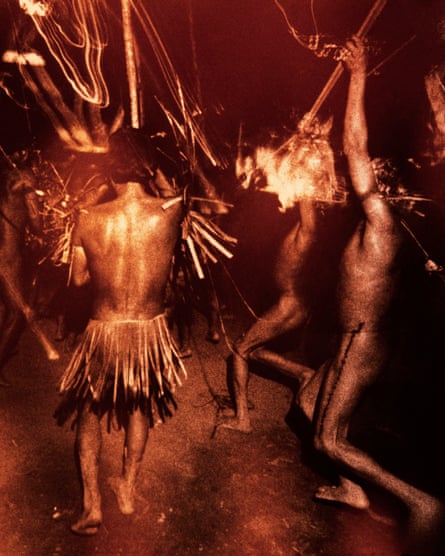
The Yanomami Struggle, by Claudia Andujar, and artwork by the Yanomami people.
The Moroccan artist Yassine Alaoui Ismaili (Yoriyas) is showing new work made during his Kyotographie artist-in-residence programme for young Africans. The images from the Japanese city feature alongside his project Casablanca Not the Movie.

Children Transform the Sheep for Eid al-Adha into a Playground in Casablanca. Photograph by Yassine Alaoui Ismaili (Yoriyas)

Yoriyas gave up his career as a breakdancer and took up photography as a means of self-expression. His project Casablanca Not the Movie documents the streets of the city where he lives with candid shots and complex compositions. His work, which combines performance and photography, encourages us to focus on how we inhabit urban spaces. The exhibition’s clever use of display and Yoriyas’s experience with choreography force the viewer to see the work at unconventional angles. He says: “The camera frame is like a theatre stage. The people in the frame are my dancers. By moving the camera, I am choreographing my subjects without even knowing it. When an interesting movement catches my eye, I press the shutter. My training has taught me to immediately understand space, movement, connection and story. I photograph in the same way that I choreograph.”

The contrasts in Casablanca take many forms, including social, political, religious and chromatic. Photograph by Yoriyas
From Our Windows is a collaboration bringing together two important Japanese female photographers, both of whom shares aspects of their lives through photography, in a dialogue about different generations. The exhibition is supported by Women in Motion, which throws a spotlight on the talent of women in the arts in an attempt to reach gender equality in the field. Rinko Kawauchi, an internationally acclaimed photographer, chose to exhibit with Tokuko Ushioda who, at 83, continues to create vibrant new works. Kawauchi says of Ushioda: “I respect the fact that she has been active as a photographer since a time when it was difficult for women to advance in society, and that she is sincerely committed to engaging with the life that unfolds in front of her.” This exhibition features photographs taken by each of them of their families.

Photograph by Rinko Kawauchi.
Kawauchi’s two bodies of work, Cui Cui and As It Is, focus on family life. The first series is a family album relating to the death of her grandfather and the second showcases the three years after the birth of her child. Family, birth, death and daily life are threads through both bodies of work that help to create an emotional experience that transcends the generations.

Rinko Kawauchi and Tokuko Ushioda at the Kyoto City Kyocera Museum of Art
Kawauchi says: “My works will be exhibited alongside Ushioda. Each of the works from the two series are in a space that is the same size, located side by side. The works show the accumulation of time that we have spent. They are a record of the days we spent with our families, and they are also the result of facing ourselves. We hope to share with visitors what we have seen through the act of photography, which we have continued to do even though our generations are different, and to enjoy the fact that we are now living in the same era.”
Ushioda’s first solo exhibition features two series: the intimate My Husband and also Ice Box, a fixed-point observation of her own and friends’ refrigerators. Ushioda says: “I worked on that series [Ice Box] for around 20 years or so. Like collecting insects, I took photographs of refrigerators in houses here and there and in my own home, which eventually culminated in this body of work.”

Entries from Tokuko Ushida’s series Ice Box.
James Mollison’s ongoing project Where Children Sleep is on display at the Kyoto Art Centre with a clever display that turns each photograph into its own bedroom.

A child portrayed in Where Children Sleep, Nemis, Canada.
Featuring 35 children from 28 countries, the project encourages viewers to think about poverty, wealth, the climate emergency, gun violence, education, gender issues and refugee crises. Mollison says: “From the start, I didn’t want to think about needy children in the developing world, but rather something more inclusive, about children from all types of situations.” Featuring everything from a trailer in Kentucky during an opioid crisis and a football fan’s bedroom in Yokohama, Japan, to a tipi in Mongolia, the project offers an engrossing look at disparate lives.
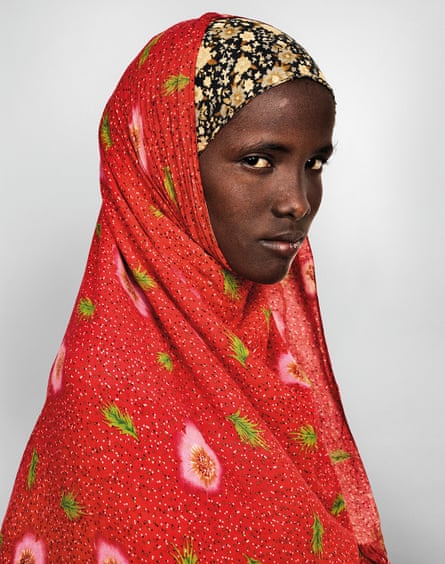
From Where Children Sleep, Nirto, Somalia

Joshim, India. Photographs by James Mollison
Phosphor, Art & Fashion (1990-2023) is the first big retrospective exhibition devoted to the Dutch artist Viviane Sassen . It covers 30 years of works, including previously unseen photographs, and combines them with video installations, paintings and collages that showcase her taste for ambiguity and drama in a distinctive language of her own.
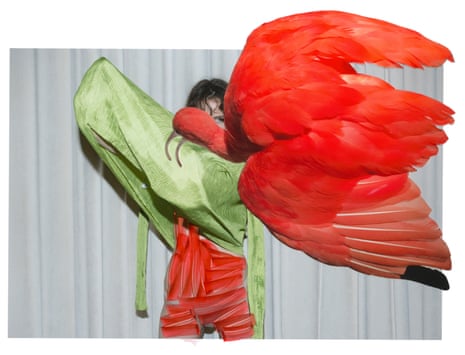
Eudocimus Ruber, from the series Of Mud and Lotus, 2017. Photograph by Viviane Sassen and Stevenson
The exhibition opens with self-portraits taken during Sassen’s time as a model. “I wanted to regain power over my own body. With a man behind the camera, a sort of tension always develops, which is often about eroticism, but usually about power,” she says. Sassen lived in Kenya as a child, and the series produced there and in South Africa are dreamlike, bold and enigmatic. She describes this period as her “years of magical thinking”. The staging of the exhibition in an old newspaper printing press contrasts with the light, shadows and bold, clashing colours of her work. The lack of natural light intensifies the flamboyant tones of the elaborately composed fashion work.

Dior Magazine (2021), and Milk, from the series Lexicon, 2006. Photographs by Viviane Sassen and Stevenson

Viviane Sassen’s immersive video installation at the Kyoto Shimbun B1F print plant. Photograph by Joanna Ruck
The source of and inspiration for Kyotographie can be traced to Lucien Clergue, the founder of Les Rencontres d’Arles, the first international photography festival, which took place in 1969. Arles, where Clergue grew up and lived all his life, was a canvas for his photography work in the 1950s. Shortly after the second world war, many Roma were freed from internment camps and came to Arles, where Clergue forged a close relationship with the community. Gypsy Tempo reveals the daily life of these families – their nomadic lifestyle, the role of religion and how music and dance are used to tell stories.
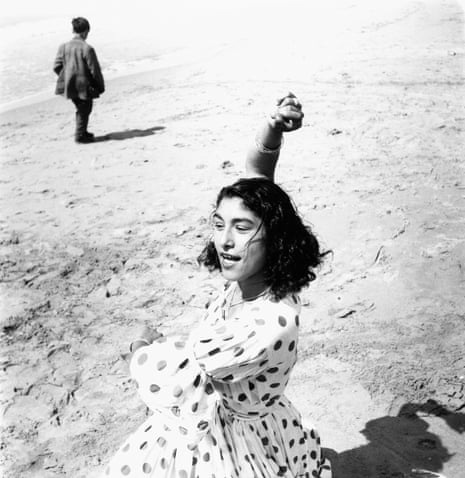
Draga in Polka-Dot Dress, Saintes-Maries-de-la-Mer, 1957. Photographs by Lucien Clergue
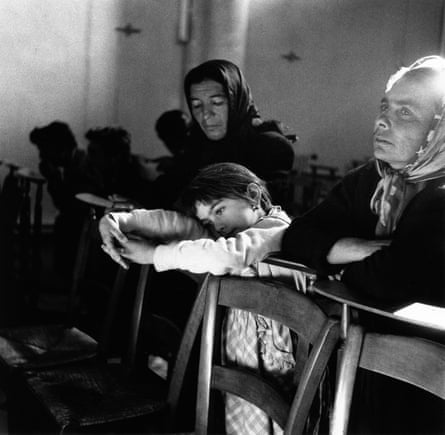
Little Gypsy Girl in the Chapel, Cannet 1958
During this time, Clergue discovered, and then helped propel to fame, the Gypsy guitarist Manitas de Plata and his friend José Reyes. Manitas went on to become a famous musician in the 1960s who, together with Clergue, toured the world, including Japan.
Kyotographie 2024 was launched alongside its sister festival, Kyotophonie , an international music event, with performances by Los Graciosos, a band from Catalonia who play contemporary Gypsy music. Meanwhile, the sounds of De Plata can be heard by viewers of Clergue’s exhibition.
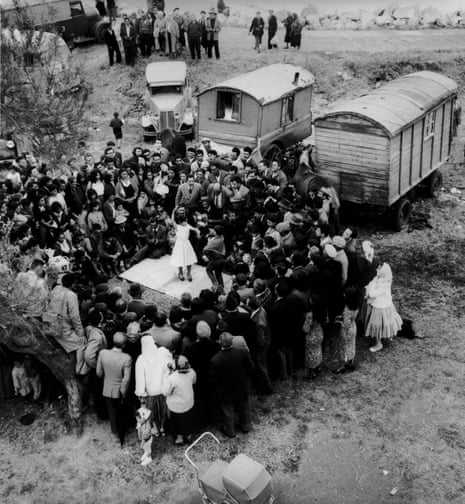
The Magic Circle, Saintes-Maries-de-la-Mer, 1958, by Lucien Clergue.
Kyotographie 2024 runs until 12 May at venues across Kyoto, Japan.
- The Guardian picture essay
- Photography
- Exhibitions
- Asia Pacific
Most viewed
Theme of Good and Evil in Beowulf
This essay about “Beowulf” examines the enduring theme of good versus evil within the narrative. It outlines how the poem sets up Beowulf as a hero combating monstrous representations of evil, such as Grendel and the dragon, which symbolize external threats and moral corruption. The text emphasizes that these battles are not just physical but also spiritual, reflecting societal values of bravery, honor, and leadership. Moreover, it discusses how evil is portrayed both as an external force and an internal challenge within the community, involving greed and betrayal. Ultimately, the essay suggests that “Beowulf” offers deep insights into the nature of morality and ethical leadership, relevant to both past and contemporary contexts. This analytical piece presents these themes in a straightforward manner, inviting readers to reflect on the complexity of morality and the continuous human struggle with good and evil.
How it works
In the realm of classic literature, few themes have endured as prominently as the battle between good and evil. This dichotomy lies at the heart of “Beowulf,” one of the earliest and most significant works in Old English poetry. The poem intricately weaves a narrative that pits the heroic Beowulf against various manifestations of evil, from monstrous creatures to morally corrupt humans. This age-old conflict not only entertains but also provides profound insights into the moral compass of the time.
“Beowulf” begins with our hero responding to the plight of King Hrothgar, whose great hall, Heorot, has been under attack by the monstrous Grendel.
Grendel himself is a creature born from sin, described as a descendant of Cain—the biblical figure punished for fratricide. This lineage immediately establishes Grendel as a symbol of intrinsic evil, lurking outside the bounds of human society and divine grace. The nightly attacks by Grendel on Heorot, a place of community and camaraderie, highlight a fundamental theme: the disruption of peace and order by the forces of evil.
The arrival of Beowulf signifies the incoming force of good. His motivations are portrayed as noble; he seeks to prove his valor but also to help those in distress. Beowulf’s battles with Grendel and, later, Grendel’s mother, are depicted not just as physical contests but as spiritual warfare. They symbolize the struggle of good to reassert the moral order that evil seeks to overthrow. Through these conflicts, Beowulf is not merely a hero in terms of physical strength but as a beacon of the values esteemed by his society: bravery, honor, and the willingness to risk one’s life for the greater good.
After defeating Grendel and his mother, Beowulf returns to Geatland, where he eventually becomes king. His rule is marked by peace and prosperity, suggesting that good leadership, guided by ethical principles, can maintain harmony within a community. However, the arrival of a dragon, many years later, introduces a new form of evil, one linked with greed and the destruction it can wreak. The dragon’s hoard, amassed over centuries and buried away from the world, represents a perverse accumulation of wealth, pointing to another shade of evil—avarice. Beowulf’s final battle with the dragon, which results in his own death, serves as a complex conclusion. It suggests that the fight against evil is ongoing and costly, possibly hinting at the inevitable flaws and failures of even the best leaders.
The portrayal of good and evil in “Beowulf” extends beyond the mere characterization of its heroes and monsters. The moral underpinnings of the poem reflect a society deeply invested in the ideals of loyalty, bravery, and the rule of law. Evil is not only an external force embodied by monsters but also internal, manifesting through greed, cowardice, and betrayal within the community. This dual nature of evil challenges the characters to maintain their moral integrity in the face of both external threats and internal temptations.
“Beowulf” is thus more than a simple tale of heroism; it is a meditation on the nature of goodness and evil. Through its vivid portrayals and symbolic characters, the poem encourages a reflection on what it means to be a good person in a world rife with both visible and subtle evils. It suggests that the battle between good and evil is not only fought on the battlefield but within the hearts of individuals and across the societies they build.
Understanding “Beowulf” in these terms offers valuable lessons on the complexity of morality and the perennial nature of human struggles with ethics. It remains profoundly relevant, reminding us that the questions of what constitutes good and how to combat evil are as pressing today as they were over a millennium ago.
Cite this page
Theme Of Good And Evil In Beowulf. (2024, Apr 22). Retrieved from https://papersowl.com/examples/theme-of-good-and-evil-in-beowulf/
"Theme Of Good And Evil In Beowulf." PapersOwl.com , 22 Apr 2024, https://papersowl.com/examples/theme-of-good-and-evil-in-beowulf/
PapersOwl.com. (2024). Theme Of Good And Evil In Beowulf . [Online]. Available at: https://papersowl.com/examples/theme-of-good-and-evil-in-beowulf/ [Accessed: 24 Apr. 2024]
"Theme Of Good And Evil In Beowulf." PapersOwl.com, Apr 22, 2024. Accessed April 24, 2024. https://papersowl.com/examples/theme-of-good-and-evil-in-beowulf/
"Theme Of Good And Evil In Beowulf," PapersOwl.com , 22-Apr-2024. [Online]. Available: https://papersowl.com/examples/theme-of-good-and-evil-in-beowulf/. [Accessed: 24-Apr-2024]
PapersOwl.com. (2024). Theme Of Good And Evil In Beowulf . [Online]. Available at: https://papersowl.com/examples/theme-of-good-and-evil-in-beowulf/ [Accessed: 24-Apr-2024]
Don't let plagiarism ruin your grade
Hire a writer to get a unique paper crafted to your needs.

Our writers will help you fix any mistakes and get an A+!
Please check your inbox.
You can order an original essay written according to your instructions.
Trusted by over 1 million students worldwide
1. Tell Us Your Requirements
2. Pick your perfect writer
3. Get Your Paper and Pay
Hi! I'm Amy, your personal assistant!
Don't know where to start? Give me your paper requirements and I connect you to an academic expert.
short deadlines
100% Plagiarism-Free
Certified writers

IMAGES
VIDEO
COMMENTS
The Pain of Isolation. Grendel's relationship with humans is defined by his intellectual interest in their philosophies, but it is also characterized by his emotional response to the concept of community. Grendel lives in a world in which his attempts at communication are continually frustrated. The animals that surround him are dumb and ...
Philosophy, Theory, and Belief. Grendel can be seen as a novel of competing ideas. Different characters try to make sense of the world in different ways, and as Grendel progresses through the novel, he must choose which set of theories or beliefs he adheres to. On one end of the spectrum, Grendel's mother experiences the world in purely ...
Grendel is a cyclical novel. It takes place in twelve chapters, respectively representing the twelve months of the year or the twelve signs of the zodiac. Seasons pass in the novel, and return the same time the following year. Even at the outset, Grendel notices that his "twelve year war" against Hrothgar is the same this year as it was the ...
Discussion of themes and motifs in John Gardner's Grendel. eNotes critical analyses help you gain a deeper understanding of Grendel so you can excel on your essay or test.
An essay connecting Grendel with Chaucer's The Nun's Priest's Tale. Jay Rudd, "Gardner's Grendel and Beowulf: Humanizing the Monster," in THOTH, Spring/Fall, 1974, pp. 3-17. A close analysis of ...
Thanks for exploring this SuperSummary Study Guide of "Grendel" by John Gardner. A modern alternative to SparkNotes and CliffsNotes, SuperSummary offers high-quality Study Guides with detailed chapter summaries and analysis of major themes, characters, and more. For select classroom titles, we also provide Teaching Guides with discussion and quiz questions to prompt student engagement.
Grendel Themes Outlook toward life. Grendel finds himself taking on polar opposites with his ideological questioning: on the one hand he grapples with nihilism, and, on the other, he sees that art and human life are meaningful. The Shaper and Unferth seem to suggest that the ideology one lives by can give meaning to one's life. On the other hand, Red Horse and the dragon are both of the ...
In "Grendel," John Gardner masterfully employs a variety of literary devices to enrich the narrative, deepen thematic explorations, and enhance the reader's engagement with the text. Here are the top 10 literary devices used in the novel: Allusion — Gardner frequently references mythology, philosophy, and classical literature, creating ...
Heroism Theme Analysis. LitCharts assigns a color and icon to each theme in Grendel, which you can use to track the themes throughout the work. In the background of the novel is perhaps English literature's most significant text about heroism: Beowulf. Whereas the epic poem Beowulf builds up the idea of a hero, much of Grendel criticizes and ...
Grendel study guide contains a biography of John Gardner, literature essays, quiz questions, major themes, characters, and a full summary and analysis. Best summary PDF, themes, and quotes. More books than SparkNotes.
Decent Essays. 568 Words. 3 Pages. Open Document. In John Gardner's Grendel, his theme can be interpreted in several manners. I see it as the author is trying to have the reader sympathize with Grendel. Others may think that Gardner is trying to make Grendel seem more monstrous; more evil. The author's intentions are portrayed by explaining ...
Thanks for exploring this SuperSummary Study Guide of "Grendel" by John Gardner. A modern alternative to SparkNotes and CliffsNotes, SuperSummary offers high-quality Study Guides with detailed chapter summaries and analysis of major themes, characters, and more. For select classroom titles, we also provide Teaching Guides with discussion and quiz questions to prompt student engagement.
Thanks for exploring this SuperSummary Study Guide of "Grendel" by John Gardner. A modern alternative to SparkNotes and CliffsNotes, SuperSummary offers high-quality Study Guides with detailed chapter summaries and analysis of major themes, characters, and more. For select classroom titles, we also provide Teaching Guides with discussion and quiz questions to prompt student engagement.
Overview. American author John Gardner 's 1971 novel Grendel offers a unique perspective on the Old English tale of Beowulf by narrating the story told in the classic of Anglo-Saxon literature from the viewpoint of the monstrous Grendel. The novel dives into the existential angst of Grendel, exploring his isolation and encounters with figures ...
One of the primary themes explored in The Coming of Grendel is the clash between good and evil. Grendel, a descendant of Cain, represents the embodiment of evil, lurking in the darkness and preying upon the innocent. In contrast, Hrothgar's mead-hall, Heorot, symbolizes the light and warmth of civilization. The poem vividly depicts the stark ...
This essay about Grendel from the epic "Beowulf" presents the monster in a new light by applying the archetype of 'The Innocent.'. Traditionally viewed as a mere antagonist, Grendel is reinterpreted as initially embodying purity and naivety, shaped negatively by harsh societal judgments. This analysis highlights Grendel's existential ...
Grendel is a monstrous creature who terrorizes the Danes by attacking and killing them in their sleep. Despite being a formidable opponent, Beowulf ultimately defeats Grendel in a fierce battle. The poem highlights the theme of heroism and monstrosity, portraying Beowulf as a noble hero and Grendel as a terrifying monster.
This essay about the visual interpretations of the epic "Beowulf" explores how artists have translated the poem's themes into art over the centuries. It discusses the depiction of key moments such as the battles with Grendel and the dragon, as well as the more reflective scenes like Beowulf's funeral.
This essay about Grendel's mother in "Beowulf" reevaluates her role beyond the traditional view of a mere antagonist, portraying her as a complex character driven by maternal instincts and a quest for vengeance. It discusses how her actions resonate with universal themes of familial duty and justice, contrasting her motivations with the ...
Beowulf Theme Essay. Beowulf is an epic poem that tells the story of Beowulf, a brave warrior who defeats the monster Grendel and saves his people. Beowulf is a great example of epic poetry, and it contains many themes that are still relevant today. Some of the important themes in Beowulf include courage, strength, loyalty, and honor.
Grendel. Likely the poem's most memorable creation, Grendel is one of the three monsters that Beowulf battles. His nature is ambiguous. Though he has many animal attributes and a grotesque, monstrous appearance, he seems to be guided by vaguely human emotions and impulses, and he shows more of an interior life than one might expect.
3. Essay On Grendel John Gardener's 'Grendel' depicts the monstrous Grendel, previously portrayed as the vicious villain in 'Beowulf, journeying through his life, attempting to achieve some kind of self-realization. Spending much of his time observing humans, Grendel develops a great disdain for religion. Gardener reinforces Grendel's with anti-religious quotes from poets and philosophers ...
Essay Example: In the epic saga "Beowulf," the contrasting characters of Grendel and Beowulf serve as fundamental opposites, representing the eternal battle between good and evil. ... and Beowulf by a combination of altruistic and legacy-driven desires. Through this comparison, the essay illuminates the poem's broader themes and the Anglo ...
Role of Monsters in Beowulf. In the epic of "Beowulf," the presence of monsters is not merely for the thrill of battle scenes or the exhibition of heroics; they serve as fundamental catalysts within the narrative, reflecting deeper cultural, psychological, and existential themes. The monsters Beowulf faces—Grendel, Grendel's mother, and ...
Photograph by Claudia Andujar. The source is the initiator, the origin of all things. It is the creation of life, a place where conflict arises or freedom is obtained; it is the space in which ...
This essay about "Beowulf" examines the enduring theme of good versus evil within the narrative. It outlines how the poem sets up Beowulf as a hero combating monstrous representations of evil, such as Grendel and the dragon, which symbolize external threats and moral corruption.